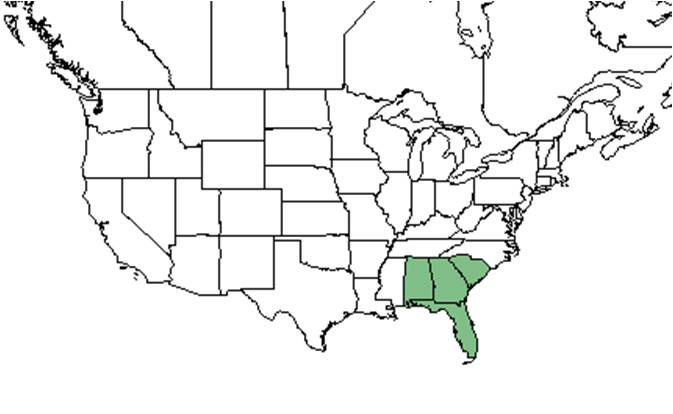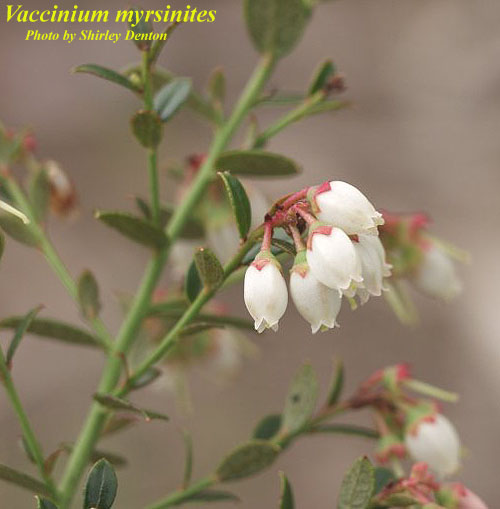Difference between revisions of "Vaccinium myrsinites"
(→Seed dispersal) |
|||
| Line 29: | Line 29: | ||
<!--===Habitat===--> <!--Natural communities, human disturbed habitats, topography, hydrology, soils, light, fire regime requirements for removal of competition, etc.--> | <!--===Habitat===--> <!--Natural communities, human disturbed habitats, topography, hydrology, soils, light, fire regime requirements for removal of competition, etc.--> | ||
===Phenology=== <!--Timing off flowering, fruiting, seed dispersal, and environmental triggers. Cite PanFlora website if appropriate: http://www.gilnelson.com/PanFlora/ --> | ===Phenology=== <!--Timing off flowering, fruiting, seed dispersal, and environmental triggers. Cite PanFlora website if appropriate: http://www.gilnelson.com/PanFlora/ --> | ||
| − | + | ''V. myrsinites'' has been observed to flower January to April with peak inflorescence in March.<ref>Nelson, G. [http://www.gilnelson.com/ PanFlora]: Plant data for the eastern United States with emphasis on the Southeastern Coastal Plains, Florida, and the Florida Panhandle. www.gilnelson.com/PanFlora/ Accessed: 14 DEC 2016</ref> | |
| + | |||
===Seed dispersal=== | ===Seed dispersal=== | ||
This species is thought to be dispersed by consumption by vertebrates. <ref name="KK"> Kay Kirkman, unpublished data, 2015. </ref> In particular, it has been found to be dispersed by the gopher tortoise (''Gopherus polyphemus'').<ref>Carlson, J. E., E. S. Menges, and P. L. Marks. 2003. Seed dispersal by Gopherus polyphemus at Archbold Biological Station, Florida. Florida Scientist, v. 66, no. 2, p. 147-154.</ref> | This species is thought to be dispersed by consumption by vertebrates. <ref name="KK"> Kay Kirkman, unpublished data, 2015. </ref> In particular, it has been found to be dispersed by the gopher tortoise (''Gopherus polyphemus'').<ref>Carlson, J. E., E. S. Menges, and P. L. Marks. 2003. Seed dispersal by Gopherus polyphemus at Archbold Biological Station, Florida. Florida Scientist, v. 66, no. 2, p. 147-154.</ref> | ||
Revision as of 20:08, 6 November 2018
| Vaccinium myrsinites | |
|---|---|

| |
| Photo by Pat Howell, Atlas of Florida Vascular Plants | |
| Scientific classification | |
| Kingdom: | Plantae |
| Division: | Magnoliophyta - Flowering plants |
| Class: | Magnoliopsida – Dicotyledons |
| Order: | Ericales |
| Family: | Ericaceae |
| Genus: | Vaccinium |
| Species: | V. myrsinites |
| Binomial name | |
| Vaccinium myrsinites Lam. | |

| |
| Natural range of Vaccinium myrsinites from USDA NRCS Plants Database. | |
Common names: Shiny blueberry, Southern evergreen blueberry
Contents
Taxonomic notes
Synonym: Cyanococcus myrsinites (Lamarck) Small var. myrsinites
Description
A description of Vaccinium myrsinites is provided in The Flora of North America.
Distribution
Ecology
Phenology
V. myrsinites has been observed to flower January to April with peak inflorescence in March.[1]
Seed dispersal
This species is thought to be dispersed by consumption by vertebrates. [2] In particular, it has been found to be dispersed by the gopher tortoise (Gopherus polyphemus).[3]
Pollination
The following Hymenoptera families and species were observed visiting flowers of Vaccinium myrsinites at Archbold Biological Station: [4]
Apidae: Nomada fervida
Halictidae: Agapostemon splendens, Augochlorella aurata, A. gratiosa, Augochloropsis anonyma, A. metallica, A. sumptuosa, Lasioglossum pectoralis
Leucospididae: Leucospis slossonae
Megachilidae: Coelioxys sayi, Megachile brevis pseudobrevis, M. mendica
Sphecidae: Ectemnius rufipes ais
Vespidae: Parancistrocerus salcularis rufulus, Pseudodynerus quadrisectus, Stenodynerus fundatiformis, S. histrionalis rufustus, S. lineatifrons
Conservation and management
Cultivation and restoration
Photo Gallery
Flowers of Vaccinium myrsinites Photo by Shirley Denton (copyrighted- use by photographer’s permission only), Atlas of Florida Vascular Plants
References and notes
- ↑ Nelson, G. PanFlora: Plant data for the eastern United States with emphasis on the Southeastern Coastal Plains, Florida, and the Florida Panhandle. www.gilnelson.com/PanFlora/ Accessed: 14 DEC 2016
- ↑ Kay Kirkman, unpublished data, 2015.
- ↑ Carlson, J. E., E. S. Menges, and P. L. Marks. 2003. Seed dispersal by Gopherus polyphemus at Archbold Biological Station, Florida. Florida Scientist, v. 66, no. 2, p. 147-154.
- ↑ Deyrup, M.A. and N.D. 2015. Database of observations of Hymenoptera visitations to flowers of plants on Archbold Biological Station, Florida, USA.
